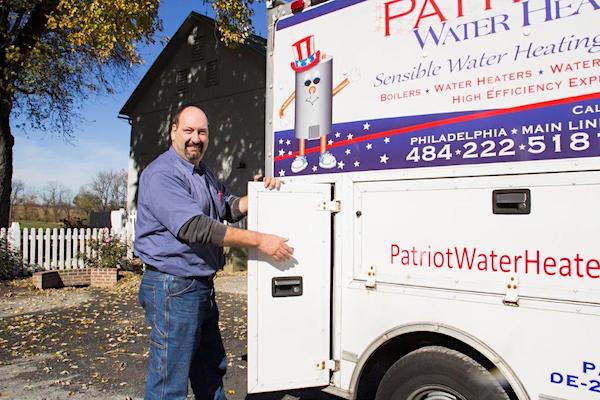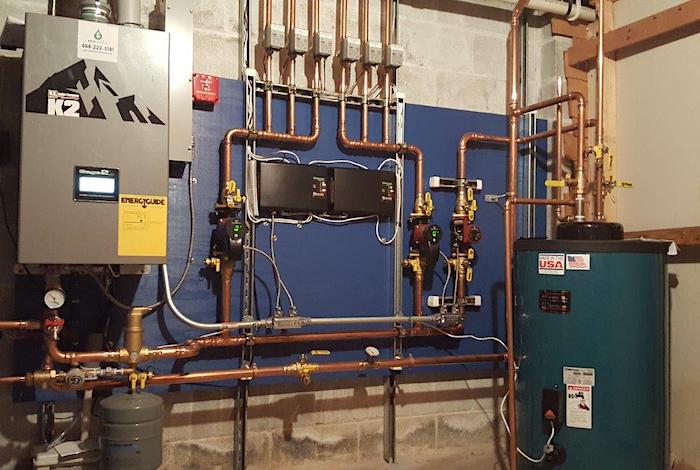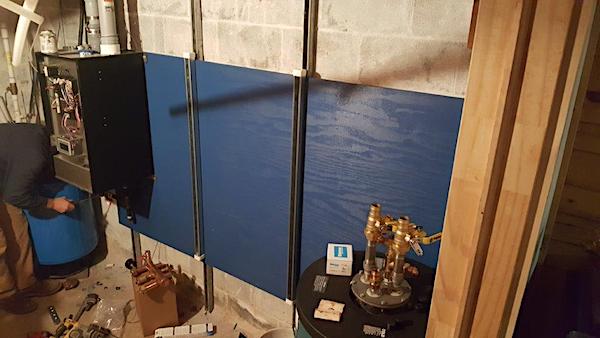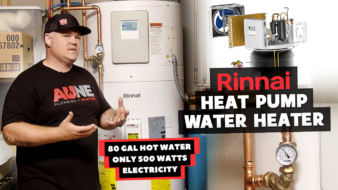Quarryville, PA, is home to a true hydronic savant. Tom Soukup, owner of Patriot Water Heater, Co., used to do general plumbing and a variety of HVAC work. However, over the past few years, he has transitioned to a sole focus on hydronic work.
“Hydronic heating—and cooling for that matter—is a truly universal form of space conditioning,” exclaimed Soukup. “What other medium has as much ability, and flexibility? I can heat your building, your spa, your DHW, melt snow, create process water, and just about anything else. And I can do it with nearly any fuel source you can think of.”
Soukup has done hydronic work since he got his start in the trades 25 years ago. Still, his recent move to all hydronic has been so deliberate that he even created a new brand, EcoDronics.

Tom Soukup, president of Patriot Water Heater, arrives to a jobsite.
“EcoDronics is our ‘unconventional’ hydronic brand,” he explained. “Think greenhouses, swimming pools, and snowmelt. It’s different than general home comfort, so the new brand reflects that.”
The move into unique water-based heating applications doesn’t mean that the company turns down typical boiler projects. Last month, a nearby homeowner asked Soukup to give a second opinion on a dying mechanical system.
Patriot Water Heater’s answer was the same as the first company that visited the home: a complete system replacement of the LP-fired boiler system was needed. The difference is how Soukup came to the conclusion, and the results he could deliver throughout the home, not just the boiler room.
“I make a point to spend a good deal of time asking what the customer wants in regard to the system as whole,” he said. “Noise, comfort, control… and whether or not there areas of the house that go unused? I need to know what the homeowner really wants so my team can deliver it.”
Murphy’s Law
This customer’s system was 25 years old, and it’s a wonder it lasted that long. Anything that could have been installed wrong, had been.
“There was no primary/secondary piping, no air elimination, no feed valve and the pump was on the return side of the boiler,” said Soukup. “The water returning to the cast iron boiler was too cool and the heat exchanger was condensing. The combustion chamber had collapsed, sections were leaking, the flue pipe was rotten, oil use cost over $3,000 per year, and the home was horribly uncomfortable. Long piping runs and high head pressures created by strange piping were causing both condensation and comfort issues.”

Soukup appreciates that U.S. Boiler Company provides a full hydronic solution: K2 boiler, Sage Zone Controls and the Alliance sidearm tank. A boiler with a 10-1 turndown ratio is complemented nicely by variable-speed pumps, making the system very responsive to the needs of the home.
The house was zoned horizontally, right down the center, instead of being zoned upstairs and downstairs. The upstairs was sweltering hot while downstairs occupants froze. The parents ran an electric space heater in their downstairs bedroom so that the kids, upstairs, wouldn’t sweat all night.
When the first contractor visited the home, they condemned the boiler but had no interest in addressing the comfort issues, or how the fin-tube radiation had been piped.
“My apprentice and I spent 16 hours analyzing and diagnosing issues before we gave a bid,” said Soukup. “First we performed a Manual J and an EDR. It became apparent that scrapping the boiler and rebuilding the mechanical room was the easy part. Rezoning the house was another story.”
Rubber meets road
Over the course of four days, Patriot Water Heater completely revolutionized the heating system. Aside from the baseboard and some copper pipe, everything was replaced.
“As is usually the case when you think things through before grabbing a pipe cutter, the install was relatively straightforward,” said Soukup
He and his apprentice, Ben Dyson, installed a K2 condensing boiler made by U.S. Boiler Company. The unit features a 10-1 turndown and provides 95% AFUE. They also used two U.S. Boiler Sage Zone Controls, which are expandable to 16 zones.

Patriot sets the big items first: K2 boiler and Alliance SL indirect tank.
“U.S. Boiler hit a home run with the K2 boiler,” said Soukup. “It’s a ton of functionality in a small box, and the controls are lightyears ahead of the competition. For example, the Sage Zone Control communicates directly with the boiler. I think being able to provide an integrated solution is important.”
Soukup and Dyson, who is a Marine reservist, broke the existing supply and return piping into six zones. A seventh was added for domestic hot water. A 35-gallon U.S. Boiler Alliance SL tank was used for nearly limitless hot water, long service, and the fact that the tank features top connections. The existing electric water heater was removed.
Fine-tuned success
“I visited the home on the morning after I fired the boiler, and the customer mentioned how nice it was to have even heat throughout the house,” said Soukup. “At the time, the outdoor temperature was 31°F and the boiler was running at 20% input. Nonetheless, there was still a little room for improvement.”
Through the K2 boiler’s touchscreen display, Soukup accessed the zone-by-zone runtime data and noticed that the living room was calling for heat too often. So, he lowered the anticipated BTUs slightly on the Sage Zone Control, and set the programmable thermostat’s temperature differential from one to two degrees. That solved the issue, and comfort levels haven’t changed.
“That’s what I love about the Sage Controls,” said Soukup. “Once I program the control, I can get really granular by looking at individual parts of the system. It allows me to fine-tune the system. Plus, if you’re going to install a modulating boiler, isn’t that the ultimate goal?”
On commercial projects specifically, Soukup has begun installing a meter on the gas valves of the systems we will be retrofitting, sometimes a year in advance. It’s a fantastic way to compare the energy use before and after a retrofit, and he can use those concrete numbers to sell the next project.
“For residential jobs like this—which don’t typically provide us with enough data collection time on the front end—we use the owner’s records,” explained Soukup.
On this job, the owners knew they’d used 2,200 gallons of fuel oil (308,000 MBH) the previous year. The year following the retrofit required 800 gallons of LP gas (73,600 MBH). Those number don’t include DHW production, either, as DHW had previously been supplied by electric, and are now provided by the boiler via the sidearm tank. And an electric space heater is no longer used in the master bedroom.
That’s a staggering improvement, but at the end of a cold winter day, it is pretty hard to quantify comfort.



